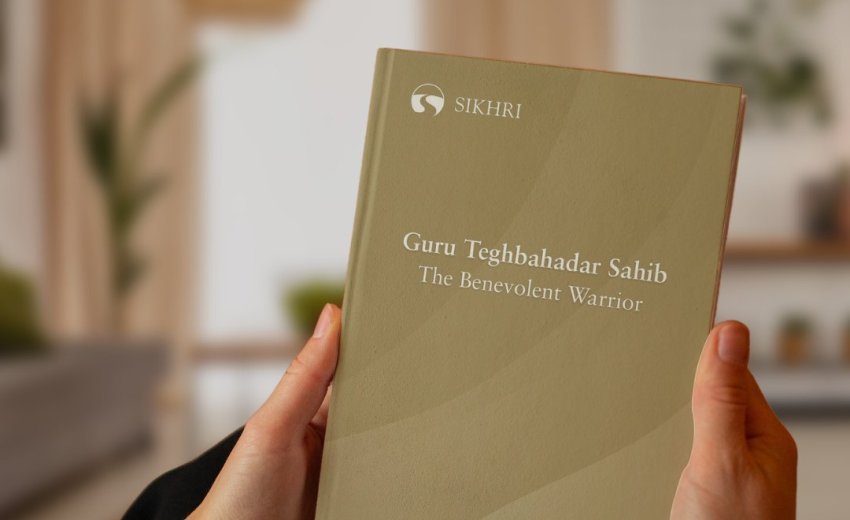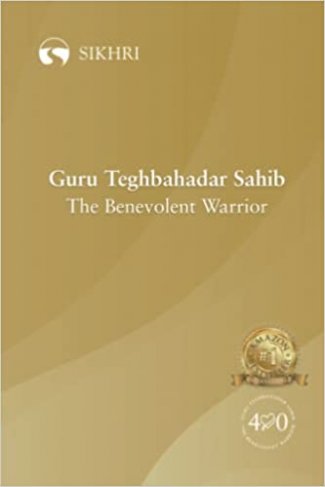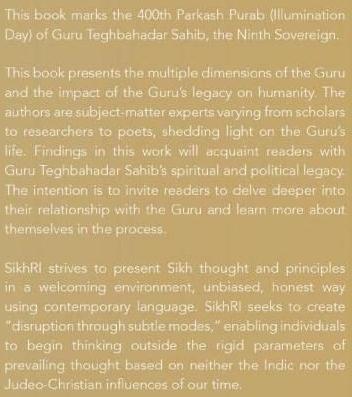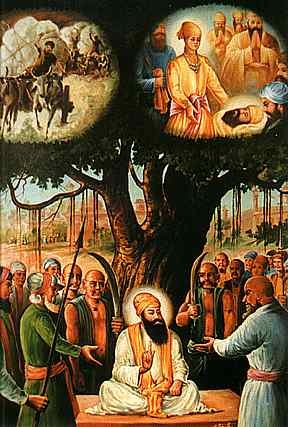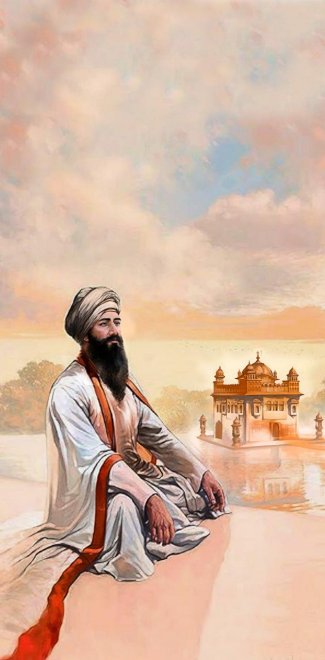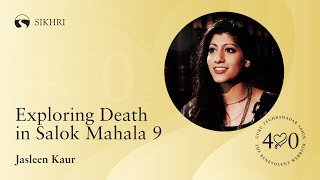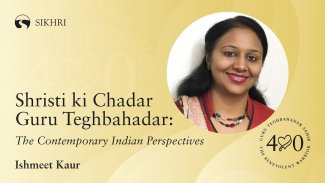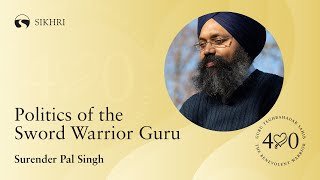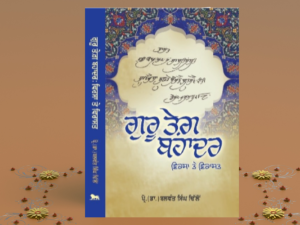Title of Book: Guru Tegbahadar Sahib: The Benevolent Warrior
Edited by: Inni Kaur & Kiranjot Kaur
Published by: Sikh Research Institute (SikhRi.org), (Paperback First Edition, Pages: 223; Price: 14.99 US$; Kindle: 6.03 US$)
Reviewed by: Prof. Hardev Singh Virk, #14017, 30 Ave, Surrey, BC, Canada
The Introduction to the book reveals that this volume is dedicated to the 400th Parkash Purab of Guru Tegbahadar Sahib, the ninth Guru of the Sikhs. The Editors emphasize the role played by the Guru in the Indian subcontinent by championing the right to live the way anyone chooses to live. The ninth Guru protected the right with his head, both through mindfulness and martyrdom. This martyrdom remains unique in the annals of world history. The aim of SikhRi is defined as ‘to create “disruption” enabling individuals to begin thinking outside the rigid parameters of prevailing thought based on neither the Indic nor the Judeo-Christian influences of our time’.
The first Chapter describes the “Life and Legacy” of Guru Tegbahadar Sahib in brief. The events leading to Guruship find a mention with emphasis on ninth Guru’s benevolent nature in forgiving Dhir Mal, the imposter. The seventh Guru, Harirai Sahib entrusted the preaching of Sikhi to Tegbahadar even before he ascended to the throne of Guruship. After assuming responsibilities of Guruship, the ninth Guru made three journeys outside Punjab. He went to preach Sikhi in East India as far as Assam and Bengal. Sikh Sangats were revived in the present states of Haryana, UP, Bihar and Assam. Patna, in Bihar, was made headquarters for the stay of the 9th Guru and family. Raja Ram Singh, the General of Aurangzeb, was entrusted with the custody of Guru Sahib and he took advantage of Guru’s presence to settle his dispute with the Ahom Raja of Assam. Both armies accepted the Guru’s intervention and a mound was raised at Dhubri to celebrate the event. There is a historic Gurdwara at Dhubri in the memory of the Guru.
The clergy of Hinduism and Islam were reporting to Aurangzeb about the increasing influence of ninth Guru’s preaching among the masses. He was captured twice but released on the intervention of Nawab Saifudin and other well wishers of the Guru. But when Aurangzeb started forced conversions of Kashmiri Pundits, their delegation, led by Pundit Kirpa Ram, approached ninth Guru for help. The rest of the story is part of Sikh history and need not be repeated here. Three conditions were laid down before the Guru: (1) Perform a Miracle, (2) Accept Islam, or (3) Get ready to accept death. The Guru rejected the first two conditions and accepted death. He was martyred in Chandni Chowk, Delhi on 11 November, 1675 at the place where stands the Gurdwara Sis Ganj, in remembrance of Guru’s unique martyrdom, today.
The editors of this volume pay glowing tributes to ninth Guru:
“Guru Teghbahadar Sahib was perfection beyond description: an eternal wisdom, a benevolent warrior, a fierce advocate, and a perfect leader for nation building. The Guru added new dimensions of social activism as well as community organizing for all communities. Guru Sahib’s resistance to the oppression of the Mughal regime echoes in the consciousness of all Sikhs today: freedom must be strived for all”.
The salient feature of the book is rendering of Slokas of Guru Tegbahadar Sahib into English by the Guru Granth Sahib Project Team of SikhRi. Each Sloka is given on the left hand page in Gurmukhi, followed by its Roman transliteration and then English translation. On the right hand side page, the gist of the Sloka is given followed by its explanation to bring home the meaning. For example, the metaphor of fish is used in the first Sloka to explain its import. The Guru says: “O my mind, you have been given this life to live in remembrance and sing the praise. You have not done that and you wasted this life away. Then comes the urging: Remember IkOnkar, the 1-Light, as the fish yearns for the water, its life source, the thing that helps it survive”.
The gist of twelfth Sloka is, “1-Light is Dwelling in Every Body”. The Guru says: “Dearest 1-Light is dwelling in everybody; saintly beings having proclaimed this again and again. Remember the 1-Light, and you will cross the ocean of fear”. The lesson is loud and clear that 1-Light (Hari) dwells in every heart and body but we look for it outside the body. Our pilgrimages and ritual baths are futile if we don’t live in remembrance of the Divine. It is like the deer running after deer-musk without realizing that it resides within his own body.
The gist of the twenty-third Sloka is, “This World is a Dream”. The Guru says: “This world is a dream, a play! Without the presence of the adorable One, the One who is to be adored, none of this is eternal”. The explanation of Sloka is rendered in simple English by the authors. This world of Maya is an illusion or dream but we still convince ourselves that this is the ultimate truth. We continue to fall prey to i-ness or me-mineness, hunted by it in its dream and fail to realize the presence of IkOnkar, the adorable One.
All these Slokas of ninth Guru remind us that nothing is permanent in this world; one who is born must die; this human body is a very rare gift of God and opportunity to get liberated; our existence in this world is like a bubble of water; all our troubles are removed if we live a life of remembrance and feel the presence of IkOnkar, in our whole entity.
Towards the end of this volume, there are six analytical essays contributed by Harinder Singh, Inni Kaur, Ishmeet Kaur. Jasleen Kaur, and Surender Pal Singh in critical appreciation of the Guru’s life and legacy. Harinder Singh has critically examined the historical sources to establish Guru Tegbahadar as Sultan-ul Duniya Wal-Akhirat (The Sovereign of the World and Hereafter). Inni Kaur tries to render three Rag Devgandhari Sabads by using transcreation to bring out the hidden meanings to establish the Guru’s way to freedom. Ishmeet Kaur delineates the Guru’s ideology and concept of martyrdom from the Slokas of ninth Guru. Jasleen Kaur traces out conceptions of death from an analysis of Salokas of ninth Guru. Surendra Pal Singh brings out salient features of Guru’s infinite dynamic personality based on his study of the political and familial responses.
The readers will find this volume a unique contribution by SikhRi on the occasion of the 400th Parkash Purab of Guru Tegbahadar Sahib. Exhaustive Notes and a select bibliography are added towards the end along with authors’ profiles and acknowledgements.
